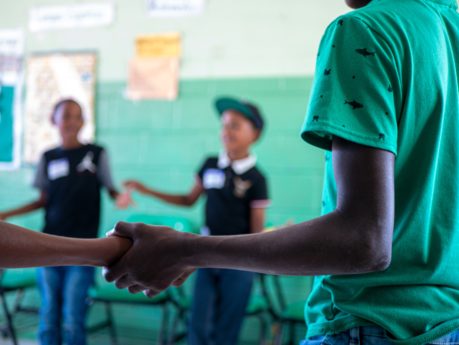The question becomes, do children have a natural instinct for compassion and giving back or is it a learned behavior? The answer is both. Yes, some kids naturally want to give to others—it’s innate to their personality. I see this in a classroom when kids read their imagine stories out loud; there’s always at least one student who naturally goes to someone who is struggling emotionally and hugs that student to make them feel better. But more typically, we need to cultivate and teach compassion, kindness, and giving in children, beginning very young and continuing until you see it becomes a natural personality trait.
There are many ways to teach the spirit of giving in our communities; volunteering at shelters, picking up trash on the sidewalks, or asking someone at school who typically doesn’t have many friends to play or be a part of something your child is doing. There are many ways parents and teachers can teach kindness, compassion, and the spirit of giving. Here are a few suggestions:
- If you see someone on a TV show you’re watching together struggling emotionally, talk with your child about the emotions that person might be feeling and suggest what you/they could do to help. When you see someone in need in person, talk with them about possibilities of giving hugs or even smiling at them with a caring look when they need to know someone is there for them.
- When old toys are outdated or becoming boring (or they even have too many), suggest they give some of their toys to kids who may have very few toys.
- Talk about the kids at school who don’t have friends, how they can be included more. Even just saying something nice to a child who is feeling left out or sad can have a major impact in the day of a child (or adult) who needs it.
- Have a child save $1 from their allowance or birthday money to give to an organization that you are all in support of.
- Do The Imagine Project writing process in your classroom or home and share your stories, the compassion will flow and their will be many opportunities to cultivate kindness and giving back to someone who might need it that day, week, or year.
The 7th step of The Imagine Project writing process asks the writer to do one act of kindness every day for 30 days. What an ample opportunity for children to learn to give back naturally. Our world will have less bullying, fewer suicides, and possibly even eliminate school shootings. There are many ways to teach and cultivate compassion and the spirit of giving—if we all pitch in and do our part to teach our kids (and participate ourselves), the world will be an even better place to live.
Love,
Dianne
The Imagine Project, Inc., a nonprofit organization that helps kids, teens, and adults overcome challenging life circumstances through expressive writing. Dianne is a thought leader in the area of stress and trauma in children. Her simple, yet profound 7-step writing tool, now used by schools across the US and internationally, gives kids and teens the opportunity to rewrite a challenging personal story and Imagine new possibilities in its place.


